Today's film special is about the French war propaganda film Mères françaises/French Mothers (René Hervil, Louis Mercanton, 1917) with a series of postcards from Italy. Star of the film was the legendary French actress Sarah Bernhardt, who was 72 at the time, but had not lost her immense star power yet.
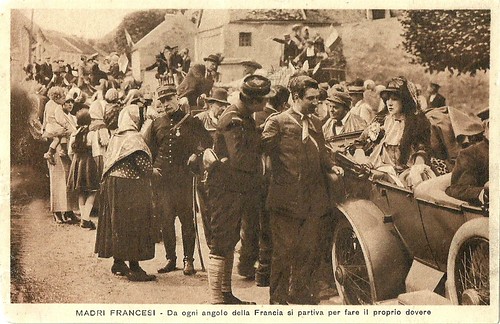
Italian postcard. Sarah Bernhardt as Mme D'Urbex in Mères françaises (René Hervil, Louis Mercanton, 1917). Caption: From every corner of France men departed to do their own duty.
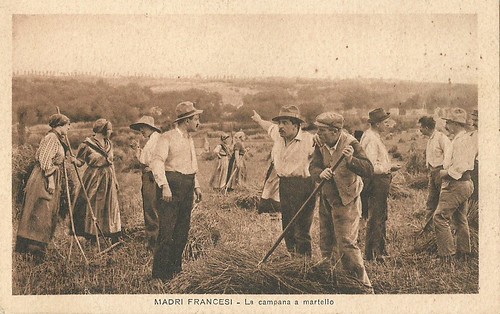
Italian postcard by IPA CT, no. 5747. Photo: publicity still for Mères françaises (René Hervil, Louis Mercanton, 1917). Caption: The bells are hammering.
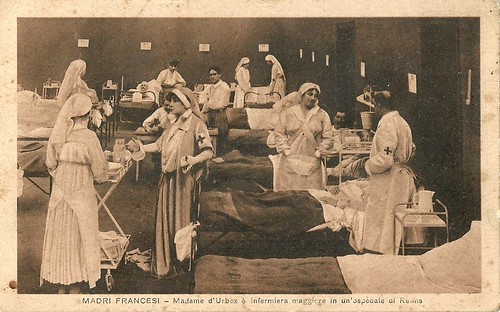
Italian postcard. Sarah Bernhardt as Mme D'Urbex in Mères françaises (René Hervil, Louis Mercanton, 1917). Caption: Mme D'Urbex is head nurse in a hospital in Reims.
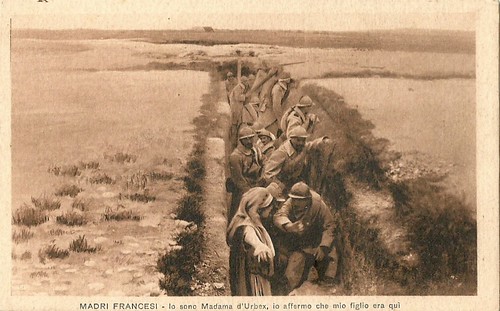
Italian postcard. Sarah Bernhardt as Mme D'Urbex in Mères françaises (René Hervil, Louis Mercanton, 1917). Caption: I am Mme D'Urbex, I confirm my son was here.
Mères françaises/French Mothers (René Hervil, Louis Mercanton, 1917) is a melodrama situated in the summer of 1914, just before the outburst of the 'great war', World War I. French mother Madame Jeanne d'Urbex (Sarah Bernhardt) lives with her husband, a retired army officer (George Deneubourg), and son Robert (Jean Angelo) at their château in the village of Mercurey in eastern France.
Jeanne is the godmother of Marie Lebroux (Louise Lagrange), the daughter of a couple who manage a farm on their estate with their son Victor and an adopted orphan, Noret (Jean Signoret).
Father Lebroux shares the pacifist views of the village schoolmaster, Guinot (Gabriel Signoret), and is equally certain that another war is impossible. But when Austro-Hungary declares war on Serbia, it isn't long before the whole of Europe is drawn into a long and bloody conflict.
With their sons, husbands and brothers away fighting for the glory of France, the womenfolk must do their duty back home - gathering in the harvest and tending to the war wounded. Madame d'Urbex is employed as a matron at Reims hospital when she learns that her son has been gravely wounded.
Determined to see him, she risks her own life by venturing close to the enemy lines, but Robert dies before she can reach him. Not long afterwards, she learns that her husband has also been killed in action.
When Guinot returns to his home village, he is blind and, out of a sense of duty, Marie feels bound to marry him. Realising that it is Noret she really loves, Guinot gives her up and urges her to marry Noret instead, insisting that the engagement takes place before Noret returns to the front. Guinot himself will return a - blinded - schoolmaster, beloved by the children and by Mme D'Urbex.
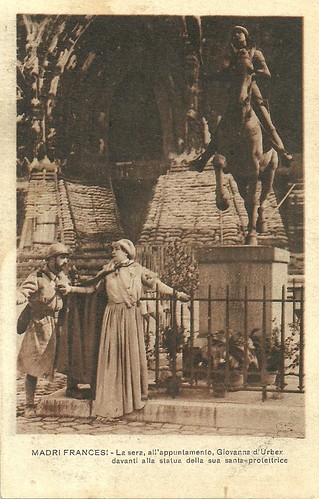
Italian postcard by IPA CT, no. 5742. Sarah Bernhardt in Mères françaises (René Hervil, Louis Mercanton, 1917). Caption: At night, at the appointment, Jeanne d'Urbex stood in front of the statue of her holy patroness.
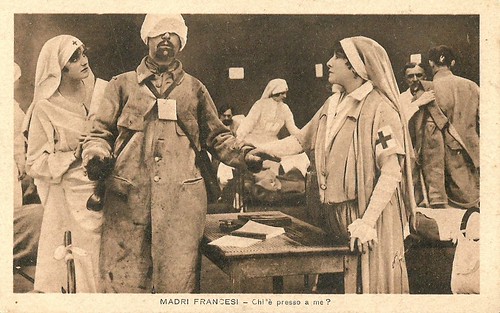
Italian postcard. Sarah Bernhardt as Mme D'Urbex and Gabriel Signoret as Guinot in Mères françaises (René Hervil, Louis Mercanton, 1917). Caption: Who is near me?
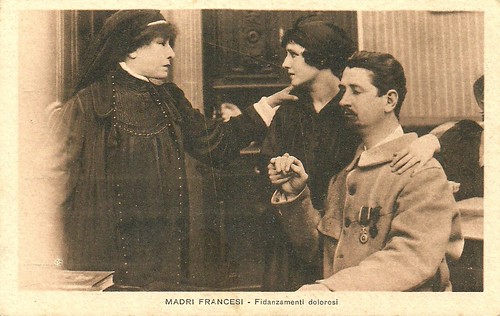
Italian postcard. Sarah Bernhardt as Mme D'Urbex, Gabriel Signoret as Guinot and Louise Lagrange as Marie in Mères françaises (René Hervil, Louis Mercanton, 1917). Caption: Sorrowful bethrothal.
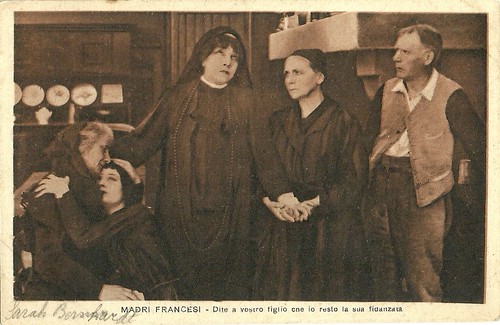
Italian postcard. Sarah Bernhardt as Mme D'Urbex and Louise Lagrange as Marie in Mères françaises (René Hervil, Louis Mercanton, 1917). Caption: Tell your son I will remain his fiancée.
Mères françaises/French Mothers (René Hervil, Louis Mercanton, 1917) was financed by the French War Ministry and intended primarily for the US market to show what World War I meant for Europe. There are many views of actual trenches, munition depots and infantry revetments. When Sarah Bernhardt plays her climactic scene standing before the statue of Joan of Arc before the Cathedral of Rheims, we can see the actual damage to the cathedral that was caused by German artillery fire.
James Travers at Le Film Guide: "as a propaganda film it is both surprisingly honest and remarkably effective. Instead of justifying the war, or even glorifying those who are actively caught up in its brutal carnage, it confines itself to the duty of the female sex, urging stoicism and resilience through a period of almost unimaginable personal anguish."
It was a vehicle for 'the most famous actress in the history of the world', French vedette Sarah Bernhardt (1844-1923). 'The Divine Sarah' had made her fame on the stages of Europe in the 1870s, and since then, she was also highly in demand in both Americas. Bernhardt became one of the first film stars and even at the age of 72, she starred in Mères Françaises.
A few years earlier, Sarah Bernhardt's right leg had to be amputated above the knee, after gangrene had set in. It was the result of an old injury. Wearing a long frock to conceal her amputation, she played the entire film by turns either sitting down or carefully standing near something to lean on. We never see her walking. Despite this handicap, Bernhardt put her own safety on risk during the shooting of the exterior scenes near Reims, within twenty kilometres of the enemy lines near the Marne.
Her male co-star was Gabriel Signoret (1878-1937) as the blind schoolmaster Guinot. Signoret played in some 85 films, mostly silent ones. In Mères Françaises his brother Jean Signoret also plays an important part as his rival in love, Noret.
The other co-star was Louise Lagrange (1898-1979), a French screen actress who had a fruitful career in French silent and sound cinema from the Pathé short Cendrillon (1907) onwards. In the early 1920s Lagrange played in the US opposite Rudolph Valentino, while in turn Ricardo Cortez and Ivan Petrovich where her partners in later 1920s French films. In 1933 she became the wife of film director Maurice Tourneur and quitted film acting, apart from just a few, small parts in postwar films.
Despite her excellent co-stars, reviewers think it was Sarah Bernhardt who carried the film. James Travers: "her vitality is still very much in evidence, and her charismatic presence redeems what would otherwise have been a dull and pedestrian wartime melodrama."
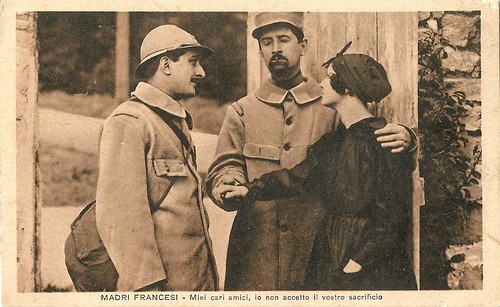
Italian postcard. Gabriel Signoret as the blind schoolmaster Guinot, Jean Signoret as Noret and Louise Lagrange as Marie in Mères françaises (René Hervil, Louis Mercanton, 1917). Caption: My dear friends, I cannot accept your sacrifice.
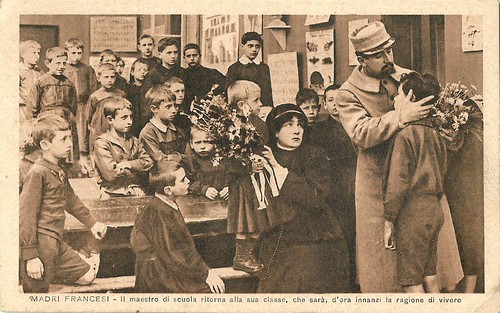
Italian postcard. Sarah Bernhardt as Mme D'Urbex and Gabriel Signoret as Guinot in Mères françaises (René Hervil, Louis Mercanton, 1917). Caption: The schoolmaster returns to his class, which henceforth will be his reason to live.
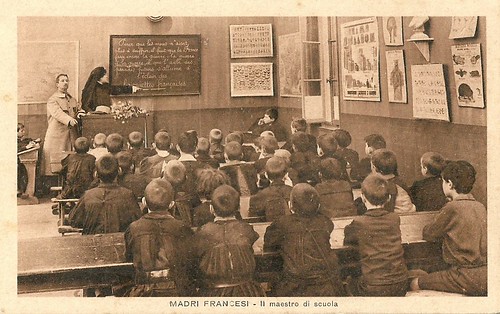
Italian postcard. Sarah Bernhardt as Mme D'Urbex and Gabriel Signoret as Guinot in Mères françaises (René Hervil, Louis Mercanton, 1917). Caption: The schoolmaster.
Scene from Mères françaises (1917). Source: Cinéma et Histoire (YouTube).
Source: James Travers (Le Film Guide) and IMDb.

Italian postcard. Sarah Bernhardt as Mme D'Urbex in Mères françaises (René Hervil, Louis Mercanton, 1917). Caption: From every corner of France men departed to do their own duty.

Italian postcard by IPA CT, no. 5747. Photo: publicity still for Mères françaises (René Hervil, Louis Mercanton, 1917). Caption: The bells are hammering.

Italian postcard. Sarah Bernhardt as Mme D'Urbex in Mères françaises (René Hervil, Louis Mercanton, 1917). Caption: Mme D'Urbex is head nurse in a hospital in Reims.

Italian postcard. Sarah Bernhardt as Mme D'Urbex in Mères françaises (René Hervil, Louis Mercanton, 1917). Caption: I am Mme D'Urbex, I confirm my son was here.
The Summer of 1914
Mères françaises/French Mothers (René Hervil, Louis Mercanton, 1917) is a melodrama situated in the summer of 1914, just before the outburst of the 'great war', World War I. French mother Madame Jeanne d'Urbex (Sarah Bernhardt) lives with her husband, a retired army officer (George Deneubourg), and son Robert (Jean Angelo) at their château in the village of Mercurey in eastern France.
Jeanne is the godmother of Marie Lebroux (Louise Lagrange), the daughter of a couple who manage a farm on their estate with their son Victor and an adopted orphan, Noret (Jean Signoret).
Father Lebroux shares the pacifist views of the village schoolmaster, Guinot (Gabriel Signoret), and is equally certain that another war is impossible. But when Austro-Hungary declares war on Serbia, it isn't long before the whole of Europe is drawn into a long and bloody conflict.
With their sons, husbands and brothers away fighting for the glory of France, the womenfolk must do their duty back home - gathering in the harvest and tending to the war wounded. Madame d'Urbex is employed as a matron at Reims hospital when she learns that her son has been gravely wounded.
Determined to see him, she risks her own life by venturing close to the enemy lines, but Robert dies before she can reach him. Not long afterwards, she learns that her husband has also been killed in action.
When Guinot returns to his home village, he is blind and, out of a sense of duty, Marie feels bound to marry him. Realising that it is Noret she really loves, Guinot gives her up and urges her to marry Noret instead, insisting that the engagement takes place before Noret returns to the front. Guinot himself will return a - blinded - schoolmaster, beloved by the children and by Mme D'Urbex.

Italian postcard by IPA CT, no. 5742. Sarah Bernhardt in Mères françaises (René Hervil, Louis Mercanton, 1917). Caption: At night, at the appointment, Jeanne d'Urbex stood in front of the statue of her holy patroness.

Italian postcard. Sarah Bernhardt as Mme D'Urbex and Gabriel Signoret as Guinot in Mères françaises (René Hervil, Louis Mercanton, 1917). Caption: Who is near me?

Italian postcard. Sarah Bernhardt as Mme D'Urbex, Gabriel Signoret as Guinot and Louise Lagrange as Marie in Mères françaises (René Hervil, Louis Mercanton, 1917). Caption: Sorrowful bethrothal.

Italian postcard. Sarah Bernhardt as Mme D'Urbex and Louise Lagrange as Marie in Mères françaises (René Hervil, Louis Mercanton, 1917). Caption: Tell your son I will remain his fiancée.
The most famous actress in the history of the world
Mères françaises/French Mothers (René Hervil, Louis Mercanton, 1917) was financed by the French War Ministry and intended primarily for the US market to show what World War I meant for Europe. There are many views of actual trenches, munition depots and infantry revetments. When Sarah Bernhardt plays her climactic scene standing before the statue of Joan of Arc before the Cathedral of Rheims, we can see the actual damage to the cathedral that was caused by German artillery fire.
James Travers at Le Film Guide: "as a propaganda film it is both surprisingly honest and remarkably effective. Instead of justifying the war, or even glorifying those who are actively caught up in its brutal carnage, it confines itself to the duty of the female sex, urging stoicism and resilience through a period of almost unimaginable personal anguish."
It was a vehicle for 'the most famous actress in the history of the world', French vedette Sarah Bernhardt (1844-1923). 'The Divine Sarah' had made her fame on the stages of Europe in the 1870s, and since then, she was also highly in demand in both Americas. Bernhardt became one of the first film stars and even at the age of 72, she starred in Mères Françaises.
A few years earlier, Sarah Bernhardt's right leg had to be amputated above the knee, after gangrene had set in. It was the result of an old injury. Wearing a long frock to conceal her amputation, she played the entire film by turns either sitting down or carefully standing near something to lean on. We never see her walking. Despite this handicap, Bernhardt put her own safety on risk during the shooting of the exterior scenes near Reims, within twenty kilometres of the enemy lines near the Marne.
Her male co-star was Gabriel Signoret (1878-1937) as the blind schoolmaster Guinot. Signoret played in some 85 films, mostly silent ones. In Mères Françaises his brother Jean Signoret also plays an important part as his rival in love, Noret.
The other co-star was Louise Lagrange (1898-1979), a French screen actress who had a fruitful career in French silent and sound cinema from the Pathé short Cendrillon (1907) onwards. In the early 1920s Lagrange played in the US opposite Rudolph Valentino, while in turn Ricardo Cortez and Ivan Petrovich where her partners in later 1920s French films. In 1933 she became the wife of film director Maurice Tourneur and quitted film acting, apart from just a few, small parts in postwar films.
Despite her excellent co-stars, reviewers think it was Sarah Bernhardt who carried the film. James Travers: "her vitality is still very much in evidence, and her charismatic presence redeems what would otherwise have been a dull and pedestrian wartime melodrama."

Italian postcard. Gabriel Signoret as the blind schoolmaster Guinot, Jean Signoret as Noret and Louise Lagrange as Marie in Mères françaises (René Hervil, Louis Mercanton, 1917). Caption: My dear friends, I cannot accept your sacrifice.

Italian postcard. Sarah Bernhardt as Mme D'Urbex and Gabriel Signoret as Guinot in Mères françaises (René Hervil, Louis Mercanton, 1917). Caption: The schoolmaster returns to his class, which henceforth will be his reason to live.

Italian postcard. Sarah Bernhardt as Mme D'Urbex and Gabriel Signoret as Guinot in Mères françaises (René Hervil, Louis Mercanton, 1917). Caption: The schoolmaster.
Scene from Mères françaises (1917). Source: Cinéma et Histoire (YouTube).
Source: James Travers (Le Film Guide) and IMDb.
No comments:
Post a Comment